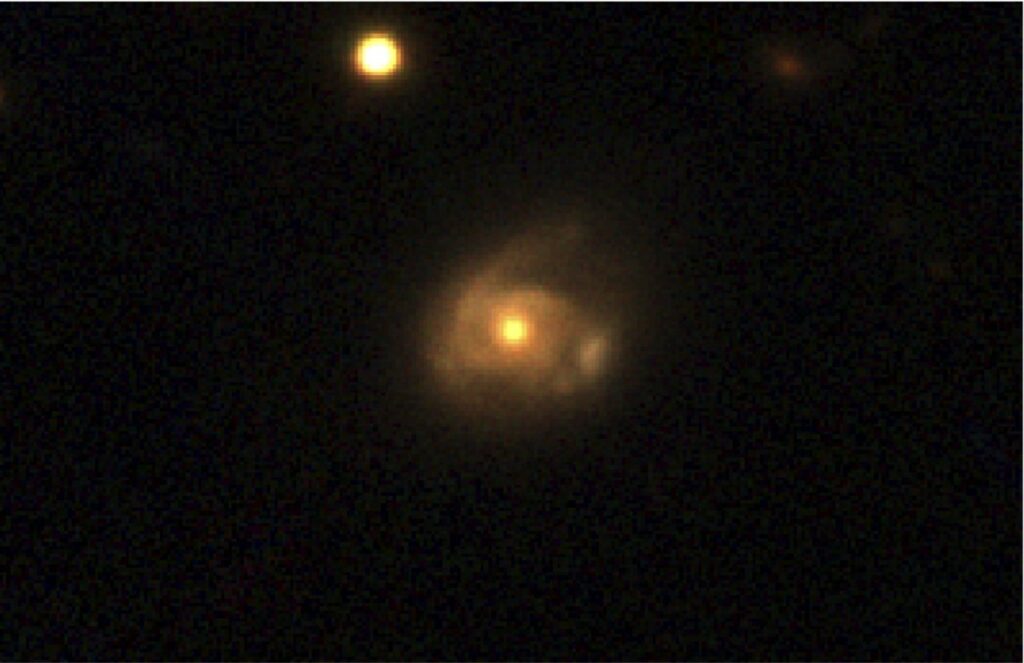Astronomers from the University of Leeds and the University of Leicester have found a supermassive black hole that is effectively “taking bites” out of a star similar to our Sun. The star loses material equivalent to three Earths each time it orbits the black hole, according to fresh data from NASA’s Neil Gehrels Swift Observatory.
The scientists describe the galactic snacking behavior as a “missing link” in our understanding of how black holes interact with orbiting stars.
Dr. Chris Nixon, Associate Professor in Theoretical Astrophysics at the University of Leeds, likens this phenomenon to a “more extreme” version of how Earth’s tides are controlled by the Moon’s gravitational pull. “This was a quiet galaxy with no detectable activity from the central supermassive black hole. Then suddenly we see bursts of X-rays,” Dr. Nixon explains in a statement.
“This tells us that a star is orbiting too close to the black hole and having its outer layers pulled off, and this matter is then pulled in by the black hole,” he continues. “The repeating nature of the outbursts tells us that the star is just about managing to hold itself together, for now.”
Tidal Forces on a Cosmic Scale
The astronomers were initially alerted to the star’s plight by a bright flash of X-rays from galaxy 2MASX J02301709+2836050, situated roughly 500 million light-years away. Using a new tool developed for the Neil Gehrels Swift Observatory, they identified the star, named Swift J0230, and noted its unusual behavior: shining brightly for 7-10 days and then abruptly turning off, resuming this cycle every 25 days.
Such extreme interactions between stars and black holes are rare within individual galaxies, happening once every 100,000 years or so. “But there are so many galaxies in the Universe that every few seconds a star is being pulled apart by a supermassive black hole somewhere out there,” says Dr. Nixon. “It’s thanks to some amazing observatories that we have such a good understanding of what is going on in distant galaxies.”

Previous research had noted stars experiencing what are called “quasi-periodic eruptions” and “periodic nuclear transients,” where material is ripped away by black holes at differing frequencies and intensities. The regularity of Swift J0230’s emissions falls between these two types, helping to fill in gaps in our understanding.
‘Another Exciting Discovery’
The star in question orbits a relatively low-mass black hole, with a mass ranging from 100,000 to a million times that of our Sun. As the star gets too close to this black hole, material is torn off and heated to around 2 million degrees Celsius. This intense heat releases a burst of X-rays that are detected by the Swift satellite.
“This is the first time we’ve seen a star like our Sun being repeatedly shredded and consumed by a low-mass black hole,” notes lead author Dr. Phil Evans from the University of Leicester.
The discovery was made possible by a new transient detector developed by the University of Leicester for the Swift satellite. “This type of object was essentially undetectable until we built this new facility. Swift is nearly 20 years old and it’s suddenly finding brand-new events,” Dr. Evans adds.
Dr. Caroline Harper, Head of Space Science at the UK Space Agency, which funded the UK Swift team, emphasizes the significance of the finding. “This is yet another exciting discovery. We look forward to even more insights about gamma-ray bursts and other massive cosmic events in the future,” she says.
The research was supported by the UK Science and Technology Facilities Council and The Leverhulme Trust. The findings are published in the journal Nature Astronomy.













